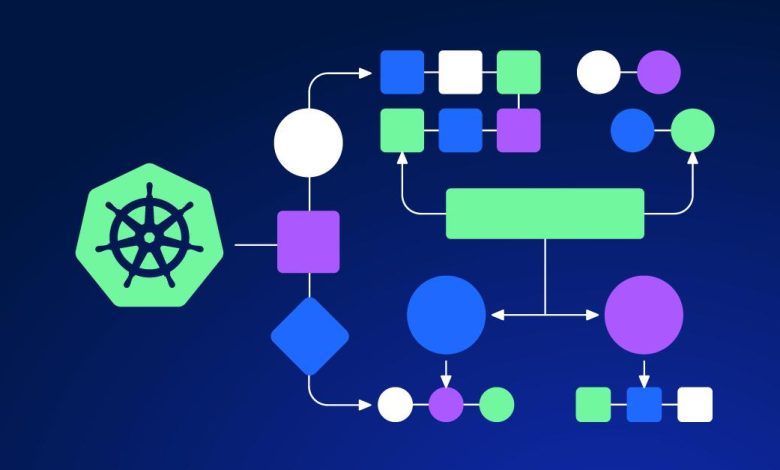
Innovation in AI is accelerating more rapidly than ever, and the demand for robust, scalable AI infrastructure has skyrocketed in turn.
But Kubernetes, the open-source system for application design and management which currently runs 54% of all AI workloads, wasn’t designed to accommodate AI’s extreme resource variability. The computing demands of AI workloads are pushing Kubernetes to its limits for cost management, resource efficiency, stability, and more. These issues reflect wider inefficiencies in Kubernetes that, without the right management tools, will inevitably lead to overprovisioning, underutilization, and escalating costs that will become unbearable.
Caught between the desire to reduce costs, the demand to maintain application speed, and faced with the pace of AI innovations, DevOps teams simply cannot afford to be bogged down by these infrastructure concerns.
Traditional Kubernetes: Functions and Limitations
Scaling applications in Kubernetes is notoriously complex, with over 80% of container costs wasted on idle resources largely due to the time it takes to scale. Many organizations react either by overprovisioning or under-provisioning their resources, yet both of these approaches come with their own problems.
Overprovisioning, while effective at ensuring stability, ultimately increases costs. Alternatively, under-provisioning keeps costs low but is liable to lead to performance bottlenecks when traffic exceeds allocated capacity. Popular Kubernetes management tools like Knative, Karpenter, Cluster-Autoscaler, and more help scale dynamically, but they still require several minutes to spin up new nodes, making overprovisioning an ongoing challenge.
Kubernetes’ configurations are also typically static, preventing real-time adjustments and complicating effective response to sudden demand surges. This was exactly the case in DeepSeek’s API service disruptions, as without an adaptive approach to Kubernetes scaling, DeepSeek was unable to prevent service disruptions and unnecessary resource waste.
The answer? Intelligent orchestration is the best way to achieve efficient AI resource distribution and mitigate unnecessary delays in AI model execution.
Kubernetes Management Needs an Upgrade
Kubernetes is still the most efficient infrastructure operator today. The problem is that the traditional approach to managing Kubernetes can no longer keep up with the fast-paced demands of AI-driven businesses.
A new management approach is necessary, one that focuses on automation and intelligent scaling, freeing up DevOps to concentrate on innovation rather than triaging resource constraints.
AI workloads require infrastructure that can adjust dynamically, enabling the allocation of compute and storage resources exactly as needed to ensure efficiency without compromising performance. Fortunately, innovations in Kubernetes that enable real-time, automated resource allocation and the instant scaling of workloads are addressing these challenges. Such an automated approach to scaling and resource allocation reduces compute waste, ensuring that critical AI workloads remain available even during unexpected surges.
The Future of AI and Kubernetes
As AI adoption accelerates, Kubernetes must continue evolving alongside the growing demands of AI-driven applications.
Consider the fact that AI workloads require vast amounts of computational operations to run in tandem, particularly during tasks like model training or inference. This operational multitasking is where GPUs excel, making them far more efficient for AI-related tasks than CPUs, which are optimized for sequential processing.
The catch? Kubernetes was originally designed with CPUs in mind, making it extremely difficult for this infrastructure to effectively manage GPU workloads. In order for Kubernetes to evolve and support the AI ecosystem, it must address the following GPU-related challenges:
- Current resource management models for GPUs lack the flexible requests-and-limits paradigm that has made CPU scheduling so straightforward.
- The limited fractioning capabilities of GPUs, as you can only subdivide a GPU into a few slices rather than in the fine-grained manner possible with CPUs, makes it hard to allocate resources with precision.
- Unlike CPUs, where the specific hardware model is often irrelevant, the type and generation of GPU can drastically impact performance, meaning that workload placement must account for these differences.
Addressing these limitations and enhancing Kubernetes for AI workloads will ultimately require native support for specialized hardware accelerators that can handle mixed workloads, possibly by developing more sophisticated resource management strategies designed to optimize GPU resource allocation.
By reimagining Kubernetes management and configuration around the native constraints of GPU computing, AI-intensive applications can maximize the performance of these processing units while maintaining the flexibility and efficiency associated with CPU-based workloads.
Compute More Completely
Kubernetes remains a powerful tool for managing computational infrastructure, offering flexibility, automation, and scalability across a wide range of workloads. But traditional management approaches simply can’t keep up with AI’s rapid growth.
As the AI landscape continues to evolve with exponential speed, businesses that have agile Kubernetes strategies will be better positioned to meet AI’s unique challenges and scale more efficiently. By utilizing advanced technologies for adaptive infrastructure management and rethinking traditional scaling methods, organizations can harness the full potential of AI without running into the pitfalls of inefficient resource allocation.
AI workloads will continue to evolve, with or without Kubernetes by its side. Only those who keep their Kubernetes infrastructure up to speed can avoid being left behind.



